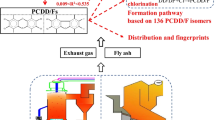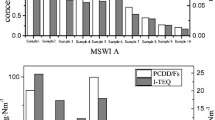Abstract
The production of cement in China is accompanied by various emissions, such as fine particulate matter, heavy metals, nitrogen oxides, sulfur oxides, carbon dioxide…. Moreover, cement kiln presents a potential health risk to its surroundings, linking to emissions of persistent organic pollutants (POPs), such as polychlorinated dibenzo-p-dioxins and dibenzofurans (PCDD/Fs), in brief dioxins. Flue gas samples were collected from five typical cement kilns during twelve runs and were used to evaluate the levels and distribution of PCDD/Fs in the emissions from cement kilns. The PCDD/Fs concentrations (136 congeners) and I-TEQ values ranged from 2.3 to >40 ng/m3 and 9.3 ∼ 90.8 × 10−3 ng I-TEQ/m3, respectively, which were lower than the emission standard in China (0.1 ng I-TEQ/m3). In weight units, the dominant congeners were OCDD, 1,2,3,4,6,7,8-HpCDF, and OCDF; 2,3,4,7,8-PeCDF is the largest contributor (36–66 %) to the total I-TEQ value of twelve runs. HxCDF and TCDF were the first two most abundant homologue groups (12–85 and 4–52 %), and the homologue concentration decreased with rising chlorine number for PCDDs. In addition, there was no marked difference in homologue profiles when solid wastes (refuse-derived fuel and municipal solid waste) and hazardous wastes (DDT and POPs) were combusted as supplemental fuels. The use of various supplemental fuels had no obvious effect on the fingerprint of PCDD/F homologues. Moreover, there was no significant difference in levels of PCDD/Fs emission due to the diversity of production capacity, which were consistent with reported previously. Air pollution control device had effect on the homologue profiles, and cement system with electrostatic precipitators (ESP) had more fractions of octachloro congeners to the total.








Similar content being viewed by others
References
Abad E, MartÍnez K, Caixach J, Rivera J (2004) Polychlorinated dibenzo-p-dioxin/polychlorinated dibenzofuran releases into the atmosphere from the use of secondary fuels in cement kilns during clinker formation. Environ Sci Technol 38:4734–4738
Altarawneh M, Dlugogorski BZ, Kennedy EM, Mackie JC (2009) Mechanisms for formation, chlorination, dechlorination and destruction of polychlorinated dibenzo-p-dioxins and dibenzofurans (PCDD/Fs). Prog Energy Combust Sci 35:245–274
Ames M, Zemba S, Green L, Botelho MJ, Gossman D, Linkov I, Palma OJ (2012) Polychlorinated dibenzo (p) dioxin and furan (PCDD/F) congener profiles in cement kiln emissions and impacts. Sci Total Environ 419:37–43
Australia E (1999) Incineration and dioxins: review of formation processes. Environmental and safety services for environment Australia. Canberra, Australia
Australia E (2002) Sources of PCDD/PCDF and furans in Australia—air emissions—revised edition. Canberra, Australia
Balbo M, Francois A, Ladebat H, Mosnier F (1998) Cement kiln incineration – a viable waste management solution. International Directory of Solid Waste Management. The ISWA Yearbook, pp. 123–127
Buekens A (2012) Incineration technologies. Springer, New York
Capmas A (2003) The French cement industry experience in the use of waste fuels. Fifth Colloquium of Managers and Technicians of Cement Plants, Sevilla
Carrasco F, Bredin N, Heitz M (2002) Gaseous contaminant emissions as affected by burning scrap tires in cement manufacturing. J Environ Qual 31:1484–1490
Conesa JA, Gálvez A, Mateos F, Martín GI, Font R (2008) Organic and inorganic pollutants from cement kiln stack feeding alternative fuels. J Hazard Mater 158:585–592
Eduljee GH (1998) PCDD/PCDF formation and control in cement kilns. Fourth International Conference on High Temperature. Filtration, Austria
Emission Standard of Air Pollutants for Cement Industry (2004) The national standard of the People’s Republic of China
Fiedler H, Lau C, Eduljee G (2000) Statistical analysis of patterns of PCDDs and PCDFs in stack emission samples and identification of a marker congener. Waste Manag Res 18:283–292
Giannopoulos D, Kolaitis D, Togkalidou A, Skevis G, Founti M (2007) Quantification of emissions from the co-incineration of cutting oil emulsions in cement plants–Part II: trace species. Fuel 86:2491–2501
Gordon M (2002) Dioxin characterization, formation and minimization during municipal solid waste (MSW) incineration: review. Chem Eng J 86:343–368
Haegermann B (2004) PCDD/F data from Heidelberg Cement. Heidelberg, Germany
Hashimoto S, Fujita T, Geng Y, Nagasawa E (2010) Realizing CO2 emission reduction through industrial symbiosis: a cement production case study for Kawasaki. Resour Conserv Recycl 54:704–710. doi:10.1016/j.resconrec.2009.11.013
Japan Ministry of Environment (2003) http://www.env.go.jp/en/topic/PCDD/PCDF/inventory.pdf
Jensen A (2004) Emission testing Chile. Santiago, Chile
Karstensen KH (2008) Formation, release and control of dioxins in cement kilns. Chemosphere 70:543–560
Kim DH, Mulholland JA, Ryu JY (2005) Formation of polychlorinated naphthalenes from chlorophenols. Proc Combust Inst 30:1245–1253
Lang T (2004) PCDD/PCDF/Furan data from Holcim. Holcim Group Support Ltd., Corporate Industrial Ecology. Holderbank, Switzerland
NATO/CCMS (1988) Scientific basis for the development of international toxicity equivalency factor (I-TEF) method of risk assessment for the complex mixtures of dioxins and related compounds. North Atlantic Treaty Organization/Committee on Challenges of Modern Society, Wasgington DC, USA
Reijnders L (2007) The cement industry as a scavenger in industrial ecology and the management of hazardous substances. J Inst Ecol 11:15–25
Reiterer H (2004) PCDD/PCDF data from Lafarge. Lafarge Centre Technique Europe Central. GMBH, Austria
Ruuskanen J, Vartiainen T, Kojo I, Manninen H, Oksanen J, Frankenhaeuser M (1994) Formation of polychlorinated dibenzo-p-dioxins and dibenzofurans in cocombustion of mixed plastics with coal: exploratory principal component analysis. Chemosphere 28:1989–1999
Wurst F, Prey T (2003) Dioxin emissions when using alternative fuels in the cement industry. ZKG Int 56:74–77
Xhrouet C, Pirard C, De Pauw E (2001) De novo synthesis of polychlorinated dibenzo-p-dioxins and dibenzofurans on fly ash from a sintering process. Environ Sci Technol 35:1616–1623
Zabaniotou A, Theofilou C (2008) Green energy at cement kiln in Cyprus—use of sewage sludge as a conventional fuel substitute. Renew Sust Energ Rev 12:531–541
Zemba S, Ames M, Green L, Botelho MJ, Gossman D, Linkov I, Palma OJ (2011) Emissions of metals and polychlorinated dibenzo-(p)-dioxins and furans (PCDD/Fs) from Portland cement manufacturing plants: Inter-kiln variability and dependence on fuel-types. Sci Total Environ 409:4198–4205
Acknowledgments
The financial support by the National Program on Key Basic Research Project of china (2011CB201500) is greatly acknowledged.
Author information
Authors and Affiliations
Corresponding author
Additional information
Responsible editor: Constantini Samara
Rights and permissions
About this article
Cite this article
Chen, T., Guo, Y., Li, X. et al. Emissions behavior and distribution of polychlorinated dibenzo-p-dioxins and furans (PCDD/Fs) from cement kilns in China. Environ Sci Pollut Res 21, 4245–4253 (2014). https://doi.org/10.1007/s11356-013-2356-8
Received:
Accepted:
Published:
Issue Date:
DOI: https://doi.org/10.1007/s11356-013-2356-8




